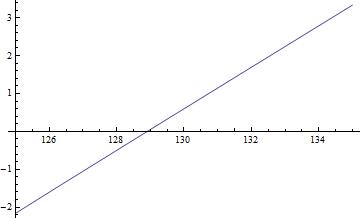I have 1 equation in 1 variable, which when I use Plot, looks like this:
i = 9
Plot[ A1[[i]]*(92)^(-1.7049946543060777) + B1[[i]]*(92)^(2.9716613209727445)-
c1[[i]]*80/0.057 + 65.89077138196083`, {H1S, 125, 135}, AxesOrigin -> {125, 0}]

Where,
A1[[9]]= -0.097752 H1S^2.70499-1.74292 H1S^4.67666 (-((0.213828 (-((1.70499
(106.316- 0.166667 H1S))/H1S^2.70499)+0.166667/H1S^1.70499))/H1S^0.266667)
+(511.685 (-(0.0311244-80/H1S^1.70499) (685034./H1S^1.70499-0.000448489 H1S^2.97166)
+(0.0358792-71./H1S^1.70499) (877653./H1S^1.70499-0.000389055 H1S^2.97166)))/
(H1S^2.97166 (-(-0.662221+1702.13/H1S^1.70499)(685034./H1S^1.70499
-0.000448489 H1S^2.97166)
+(-0.763386+1702.13/H1S^1.70499) (877653./H1S^1.70499-0.000389055 H1S^2.97166))));
B1[[9]]= (0.213828 (-((1.70499 (106.316-0.166667 H1S))/H1S^2.70499)
+0.166667/H1S^1.70499))/H1S^0.266667-(511.685 (-(0.0311244-80/H1S^1.70499)
(685034./H1S^1.70499-0.000448489 H1S^2.97166)+(0.0358792-71./H1S^1.70499)
(877653./H1S^1.70499-0.000389055 H1S^2.97166)))/(H1S^2.97166
(-(-0.662221+1702.13/H1S^1.70499) (685034./H1S^1.70499-0.000448489 H1S^2.97166)
+(-0.763386+1702.13/H1S^1.70499) (877653./H1S^1.70499-0.000389055 H1S^2.97166)));
c1[[9]]= -((-(0.0311244-80/H1S^1.70499) (685034./H1S^1.70499-0.000448489 H1S^2.97166)
+(0.0358792-71./H1S^1.70499) (877653./H1S^1.70499-0.000389055 H1S^2.97166))/
(-(-0.662221+1702.13/H1S^1.70499) (685034./H1S^1.70499-0.000448489 H1S^2.97166)
+(-0.763386+1702.13/H1S^1.70499) (877653./H1S^1.70499-0.000389055 H1S^2.97166)));
But when I use FindRoot to get the same solution,
i = 9;
FindRoot[ A1[[i]]*(92)^(-1.7049946543060777) + B1[[i]]*(92)^(2.9716613209727445)
- c1[[i]]*80/0.057 + 65.89077138196083` == 0, {H1S, 125, 120, 135}]
I get two "things" and the messages :
- Infinite expression 1/0 encountered
- Further output of Power::Infy will be supressed during this this calculation
and then it spits out what looks like the right solution if Plot is to be trusted
{H1S -> 128.907}
What am I doing wrong and how can solve this without the error messages? If the expressions was going to Infinity then it should show up on the Plot but the Plot looks well behaved. Perhaps some derivative is going to infinity during the FindRoot process. I have tried other methods specified in the "More Information" : "Brent" and "Secant" but am getting the same errors.
